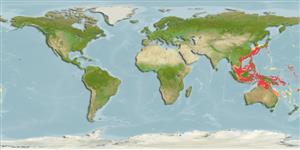Environment: milieu / climate zone / depth range / distribution range
Ecologia
marino demersale; distribuzione batimetrica ? - 450 m (Ref. 100719). Subtropical
Western Pacific: Japan to Indonesia.
Size / Peso / Age
Maturity: Lm ? range ? - ? cm
Max length : 24.1 cm SL maschio/sesso non determinato; (Ref. 44136)
Plain, with silvery sides, a barred caudal fin and rounded snout, somewhat reminiscent of the silver oceanic or pelagic pufferfishes Lagocephalus that occur in the same area and represents a possible case of mimicry (Ref. 48636).
Inhabits sandy and muddy areas in coastal waters (Ref. 9137). Seen in small groups in about 15 m depth (Ref. 48636).
Life cycle and mating behavior
Maturities | Riproduzione | Spawnings | Egg(s) | Fecundities | Larve
Masuda, H. and G.R. Allen, 1993. Meeresfische der Welt - Groß-Indopazifische Region. Tetra Verlag, Herrenteich, Melle. 528 p. (Ref. 9137)
IUCN Red List Status (Ref. 130435)
Threat to humans
Harmless
Human uses
Pesca: commerciale
Strumenti
Special reports
Download XML
Fonti Internet
Estimates based on models
Preferred temperature (Ref.
123201): 15.4 - 27.7, mean 23 °C (based on 579 cells).
Phylogenetic diversity index (Ref.
82804): PD
50 = 0.5000 [Uniqueness, from 0.5 = low to 2.0 = high].
Bayesian length-weight: a=0.00955 (0.00454 - 0.02011), b=3.10 (2.93 - 3.27), in cm total length, based on LWR estimates for this Genus-body shape (Ref.
93245).
Trophic level (Ref.
69278): 4.2 ±0.29 se; based on food items.
Resilienza (Ref.
120179): Medio, tempo minimo di raddoppiamento della popolazione 1.4 - 4.4 anni (Preliminary K or Fecundity.).
Fishing Vulnerability (Ref.
59153): Low vulnerability (19 of 100).
